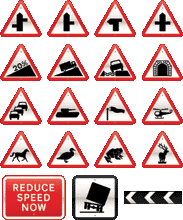Visual Processing and Dyslexia

It has been found that dyslexics are slower to interpret traffic signs. Brachacki et al. tested ten adults with dyslexia and 11 controls on their ability to differentiate between real and false traffic signs. The stimuli, computer-presented color pictures, were chosen to minimize the applicability of verbal or written linguistic skills to the task. The adults with dyslexia recognized the traffic signs significantly less well than did the controls. Furthermore, whereas for the controls there was a significant correlation between traffic sign recognition and driving experience, no such correlation was found for the adults with dyslexia.
Recently, researcher Hermundur Sigmundsson and his colleagues at the Norwegian University of Science and Technology in Trondheim gave two simulated driving tests to six dyslexic volunteers and 11 other people. They were shown road signs as they drove on simulated country and city roads at different speeds. The researchers found that dyslexics were 20 percent slower to react to traffic signs during the rural drive and 30 percent slower to react in the city than the non-dyslexic controls. “Drivers just over the UK's (United Kingdom's) alcohol limit, which can be exceeded by drinking two pints of beer, are typically 10 percent slower than normal to react,” according to the New Scientist magazine. This means that dyslexia can slow a driver's reaction time as much as drinking moderate amounts of alcohol, according to the study.
These studies confirm that dyslexics have deficits in visual processing, especially form discrimination and visual processing speed.
|
Edublox offers multisensory cognitive enhancement programs, aimed at the development of foundational learning skills such as form discrimination and visual processing speed. Our programs are effective for a variety of learning difficulties including dyslexia and dysgraphia.
|
|
